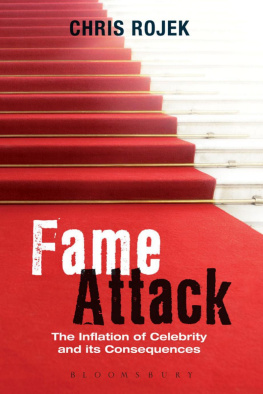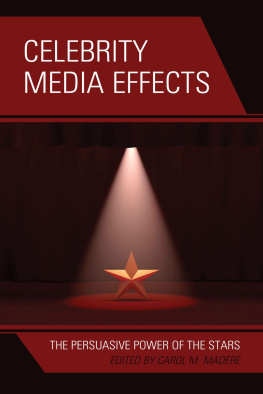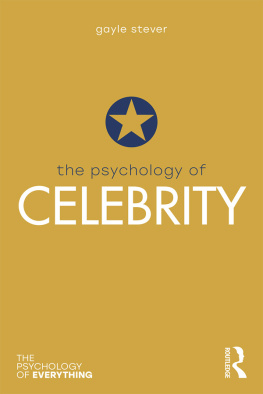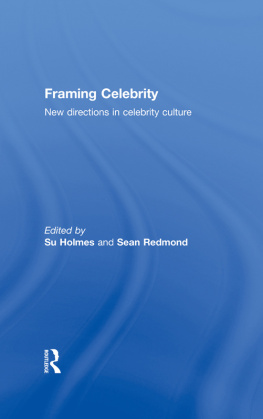Celebrity

Focus on Contemporary Issues ( FOCI ) addresses the pressing problems, ideas and debates of the new millennium. Subjects are drawn from the arts, sciences and humanities, and are linked by the impact they have had or are having on contemporary culture. FOCI books are intended for an intelligent, alert audience with a general understanding of, and curiosity about, the intellectual debates shaping culture today. Instead of easing readers into a comfortable awareness of particular fields, these books are combative. They offer points of view, take sides and are written with passion.
SERIES EDITORS
Barrie Bullen and Peter Hamilton
In the same series
Cool Rules
Dick Pountain and David Robins
Chromophobia
David Batchelor
Global Dimensions
John Rennie Short
Celebrity
CHRIS ROJEK
REAKTION BOOKS
For Ian and Alison Eastment,
celebrities in their own fashion
Published by Reaktion Books Ltd
33 Great Sutton Street
London EC V DX , UK
www.reaktionbooks.co.uk
First published 2001
Copyright Chris Rojek, 2001
All rights reserved
No part of this publication may be reproduced, stored in a retrieval system, or transmitted, in any form or by any means, electronic, mechanical, photocopying, recording or otherwise, without the prior permission of the publishers.
Page references in the Photo Acknowledgements and
Index match the printed edition of this book.
Designed by Libanus Press
Printed and bound by Biddles Limited, Guildford and Kings Lynn
British Library Cataloguing in Publishing Data
Rojek, Chris
Celebrity. (FOCI)
1.Fame 2. Celebrities
I. Title
306.4
e ISBN : 9781861895578
Contents
The intellect cannot conquer vanity. Nor is it an accident that the word vanity is close to void .
Leszek Kolakowski, philosopher and social theorist
This new look is a cross between polka dots and skin rash simulating infection and disease. Ive done it this way because I still like wearing make-up but I dont want to be a gender bender basically I never want to look ordinary .
Leigh Bowery, Anglo-Australian performance artist, and celebrated model for the painter Lucien Freud
To do is to be (Marx)
To be is to do (Sartre)
Do be do be do (Sinatra)
Student graffiti

CHAPTER ONE
Celebrity and Celetoids
Although God-like qualities are often attributed to celebrities, the modern meaning of the term celebrity actually derives from the fall of the gods, and the rise of democratic governments and secular societies. This is no accident. The increasing importance of the public face in everyday life is a consequence of the rise of public society, a society that cultivates personal style as the antidote to formal democratic equality. The Latin root of the term is celebrem , which has connotations with both fame and being thronged. There is also a connection in Latin with the term celere , from which the English word celerity derives, meaning swift. The Latin roots indicate a relationship in which a person is marked out as possessing singularity, and a social structure in which the character of fame is fleeting. The French word clbre , meaning well known in public, carries similar connotations. In addition, it suggests representations of fame that flourish beyond the boundaries of religion and Court society. In a word, it ties celebrity to a public , and acknowledges the fickle, temporary nature of the market in human sentiments. These are prominent themes in contemporary social theory. Indeed, modernity is often understood as a condition defined by the spread of episodic, anonymous relations in culture, and the increasing speed of change in social and economic life.
In this book I treat celebrity as the attribution of glamorous or notorious status to an individual within the public sphere. Several caveats must be added to this definition. First, glamour and notoriety are usually thought of in polarized terms. The Brazilian model Gisele Bundchen is glamorous; Timothy McVeigh, the Oklahoma City bomber, is notorious. Glamour is associated with favourable public recognition. Notoriety is unfavourable public recognition. Notoriety is a sub-branch of celebrity culture, and, arguably, an increasingly important one. Leaving moral considerations aside, what connects Bundchen to McVeigh is cultural impact. We might reduce this to an admittedly rather crude equation: celebrity = impact on public consciousness. The equation will certainly have to be modified in what follows, but as a starting point it will help to focus the discussion on what, today, is justly described as the public addiction to celebrity. Why do so many of us measure our worth against figures we have never met? Why is the desire for fame so widespread among ordinary people? The answers have something to do with the way that public life is constructed. The media determine this idiom, although the content remains a matter of political and ideological exchange. The scheduling of emotions, presentation of self in interpersonal relations and techniques of public impression management, which employ media celebrities to humanize and dramatize them, permeate ordinary social relationships.
Second, the question of who is attributing celebrity status is moot. Celebrities are cultural fabrications. Their impact on the public may appear to be intimate and spontaneous. In fact, celebrities are carefully mediated through what might be termed chains of attraction. No celebrity now acquires public recognition without the assistance of cultural intermediaries who operate to stage-manage celebrity presence in the eyes of the public. Cultural intermediaries is the collective term for agents, publicists, marketing personnel, promoters, photographers, fitness trainers, wardrobe staff, cosmetics experts and personal assistants. Their task is to concoct the public presentation of celebrity personalities that will result in an enduring appeal for the audience of fans. This holds good for the public presentation of notorious celebrities. The fiction of James Ellroy and Jake Arnott spins a mantle of glamour around notorious historical celebrity figures like Lee Harvey Oswald, Sam Giancano and Reggie and Ronnie Kray. In the 1990s, movie directors like Quentin Tarantino and Guy Ritchie, now Madonnaa husband, glamorized the Underworld in films like Reservoir Dogs , Pulp Fiction , Jackie Brown , Lock, Stock & Two Smoking Barrels and Snatch .
Third, celebrity status always implies a split between a private self and a public self. The social psychologist George Herbert Mead argued that the split between the I (the veridical self) and the Me (the self as seen by others) is the human condition, at least since ancient times, in Western society. The public presentation of self is always a staged activity, in which the human actor presents a front or face to others while keeping a significant portion of the self in reserve. For the celebrity, the split between the I and the Me is often disturbing. So much so, that celebrities frequently complain of identity confusion and the colonization of the veridical self by the public face. Cary Grant dealt with this ironically by remarking that he, like his audience, would love to be like Cary Grant, by which he meant that even he acknowledged the split between his public face and his veridical self. Other celebrities suffer a clinical or sub-clinical loss of identity. For example, Peter Sellers complained that he disappeared once a film role ended. This suggests that his sense of veridical self was virtually extinguished. Contrarily, the veridical self may make increasingly desperate attempts to overcome the tyranny of the public face. This may result in a pathological slippage between the I and the Me, as the public face resorts to more dramatic attempts in order to alert the public to the horror, shame and encroaching helplessness of the veridical self. Keith Moon, The Whos former drummer, and the late film star Oliver Reed are examples of chronic identity slippage. This may be understood as a pathological condition, since the public face of both celebrities became increasingly dependent on alcohol and, in Moons case, drugs too.
Next page








